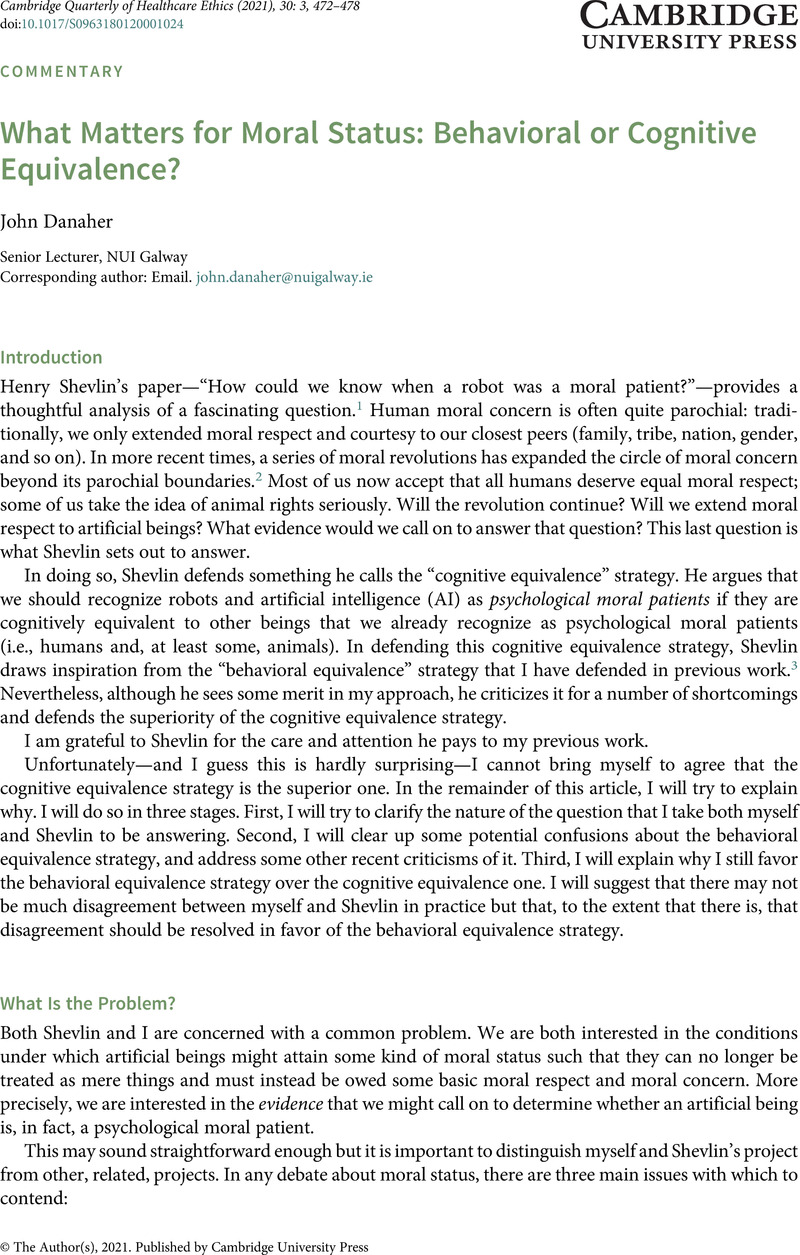Article contents
What Matters for Moral Status: Behavioral or Cognitive Equivalence?
Published online by Cambridge University Press: 10 June 2021
Abstract

- Type
- Commentary
- Information
- Copyright
- © The Author(s), 2021. Published by Cambridge University Press
References
Notes
1. Shevlin, H. How could we know when a robot was a moral patient? Cambridge Quarterly of Healthcare Ethics 30(3):459–71. available at https://doi.org/10.1017/S0963180120001012.Google Scholar
2. Singer, P. The Expanding Circle. Princeton, NJ: Princeton University Press; 1981Google Scholar; Buchanan, A, Powell, R. The Evolution of Moral Progress: A Biocultural Theory. Oxford: Oxford University Press; 2018.CrossRefGoogle Scholar
3. See, for example, Danaher, J. The philosophical case for robot friendship. Journal of Posthuman Studies 2019;3(1):5–24CrossRefGoogle Scholar; Danaher, J. Welcoming robots into the moral circle: A defence of ethical behaviourism. Science and Engineering Ethics 2020a;26:2023–49CrossRefGoogle ScholarPubMed; Danaher, J. Robot betrayal: A guide to the ethics of robotic deception. Ethics and Information Technology 2020b;22:117–28CrossRefGoogle Scholar; Danaher, J. Sexuality. In: Dubber, M, Pasquale, F, Das, S, eds. Oxford Handbook of Ethics of Artificial Intelligence. Oxford: Oxford University Press; 2020c.Google Scholar
4. See note 3, Danaher 2020a.
5. Nyholm, S. Humans and Robots: Ethics, Agency, and Anthropomorphism. London: Rowman Littlefield International; 2020.Google Scholar
6. Smids, J. Danaher’s ethical behaviourism: An adequate guide to assessing the moral status of a robot? Science and Engineering Ethics 2020. available at: doi:10.1007/s11948-020-00230-4.CrossRefGoogle Scholar
7. Nyholm actually focuses on other applications of ethical behaviourism in his criticism, particularly its application to friendship. This does not affect the point being made here though.
8. See note 6, Smids 2020, at 6 onward.
9. See note 6, Smids 2020, at 10 onward.
10. See note 3, Danaher 2020a.
11. See note 3, Danaher 2019.
12. See note 3, Danaher 2020c.
13. See note 1, Shevlin 2020.
14. See note 1, Shevlin 2020.
15. See note 1, Shevlin 2020, at chap. 3.5.
16. See note 3, Danaher 2020a.
17. See note 1, Shevlin 2020.
- 7
- Cited by


